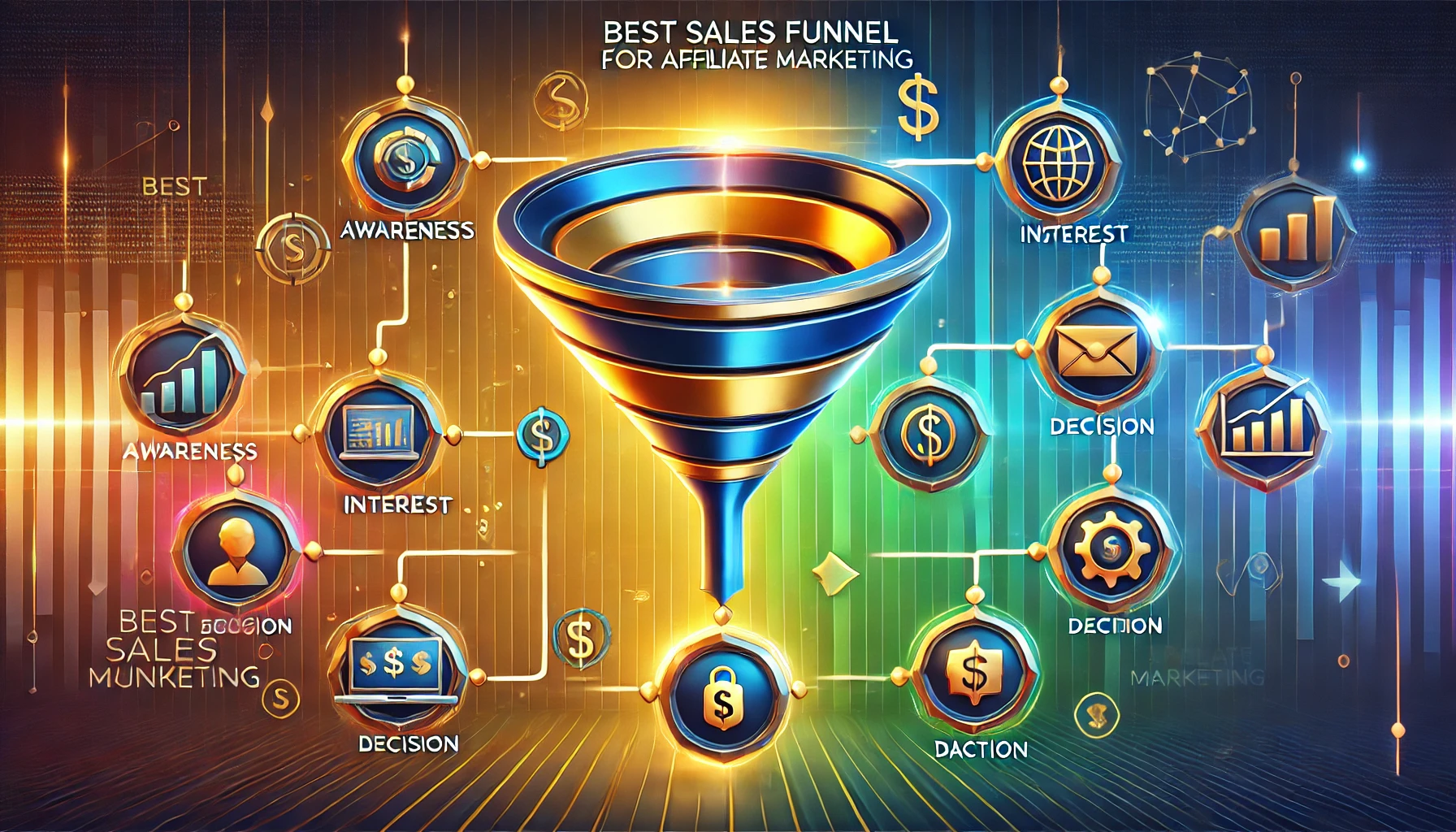In the world of online marketing, having the right sales funnel is key to success.
When it comes to affiliate marketing, understanding the best sales funnel for affiliate marketing can significantly improve your conversions and overall revenue.
Affiliate marketing has grown into a highly competitive field, and knowing how to guide potential customers from awareness to purchase through a structured funnel is essential.
In this blog, we’ll explore the fundamentals of sales funnels in affiliate marketing, determine the best strategies to build an effective funnel, and answer some of the most frequently asked questions such as “Do sales funnels work in affiliate marketing?”
“What is the best sales funnel for affiliate marketing?”, “How to build a sales funnel for affiliate marketing?”, and “Which method is best for affiliate marketing?”.
1. Do Sales Funnels Work in Affiliate Marketing?
Before diving into the technicalities, it’s essential to address the question: Do sales funnels work in affiliate marketing? The short answer is yes—sales funnels are critical to success in affiliate marketing. Here’s why:
Affiliate marketing typically involves promoting a product or service through a unique link that tracks conversions. However, simply dropping an affiliate link on a webpage or social media post is not enough to drive consistent sales. This is where a sales funnel comes into play.
A sales funnel guides potential customers through a series of stages, from learning about a product to making a purchasing decision. In the affiliate marketing context, this helps to build trust, educate the customer, and encourage them to purchase through your affiliate link.
Essentially, a sales funnel helps you automate the process of converting visitors into paying customers, which is why it’s so effective.
Why Sales Funnels Work in Affiliate Marketing:
- Trust Building: Most people don’t make a purchase the first time they hear about a product. A funnel allows you to nurture leads over time, giving you multiple touchpoints to build trust and establish credibility.
- Better Engagement: With a funnel, you can deliver personalized content, such as emails or blog posts, based on where your prospect is in the buying process.
- Automated Process: Once set up, a sales funnel can automatically drive traffic, nurture leads, and convert them into customers without requiring constant manual effort.
- Increased Conversions: When potential customers are guided through a structured journey, they’re more likely to make a purchase than if they’re sent directly to an affiliate link with no context.
2. What is the Best Sales Funnel for Affiliate Marketing?
The best sales funnel for affiliate marketing depends on your target audience, product, and promotional strategies. However, there are general frameworks that consistently produce strong results for affiliate marketers. Here’s a breakdown of the most common types of sales funnels used in affiliate marketing:
1. The Lead Magnet Funnel:
One of the most effective sales funnels for affiliate marketing is the lead magnet funnel. In this funnel, you offer potential customers a free piece of valuable content in exchange for their email address. The lead magnet could be a free ebook, a checklist, a video course, or a webinar.
- Step 1: Traffic is driven to a landing page offering a free lead magnet.
- Step 2: The visitor opts in by providing their email address.
- Step 3: You deliver the lead magnet via email and begin a follow-up email sequence.
- Step 4: Over the course of the email sequence, you introduce the affiliate product as a solution to a problem the subscriber is facing.
- Step 5: The subscriber is taken to a product sales page via your affiliate link.
This funnel works because it provides value upfront, allowing you to capture the visitor’s contact information and build a relationship before promoting the affiliate offer.
2. The Bridge Funnel:
The bridge funnel is designed to “bridge the gap” between your audience and the affiliate product you’re promoting. It’s especially useful when there’s a need to explain the benefits of the product or when there’s a trust gap between your audience and the product owner.
- Step 1: The visitor is taken to a bridge page (a landing page) that explains how the product has helped you or why it’s valuable.
- Step 2: You pre-sell the product through the bridge page, addressing potential objections and concerns.
- Step 3: The visitor is directed to the affiliate product sales page via your link.
This funnel works well when there’s a need to personalize the product or establish why it’s the best solution for your audience.
3. The Webinar Funnel:
Webinars are incredibly powerful for high-ticket affiliate products or services. In a webinar funnel, you drive traffic to a registration page for a live or automated webinar where you present the product.
- Step 1: Drive traffic to a registration page for a free webinar.
- Step 2: Present valuable content during the webinar, providing insight and solutions to the audience’s problems.
- Step 3: Toward the end of the webinar, introduce the affiliate product as the ideal solution.
- Step 4: Direct viewers to purchase the product via your affiliate link.
Webinars work because they allow you to engage directly with your audience, provide in-depth information, and build a high level of trust. This is especially effective for high-value products.

3. How to Build a Sales Funnel for Affiliate Marketing
Building a sales funnel for affiliate marketing involves several steps, but once you understand the process, it becomes easier to implement. Below is a step-by-step guide to creating an effective sales funnel.
Step 1: Understand Your Target Audience
The first step to building any sales funnel is understanding who your audience is, what their pain points are, and what solutions they’re looking for. Without this information, it’s difficult to create a funnel that will resonate with your potential customers.
- Research: Use tools like Google Trends, Facebook Audience Insights, and other market research tools to gather information about your audience.
- Identify Pain Points: What problems does your audience have that the affiliate product solves? This will help you craft messages that speak directly to their needs.
Step 2: Choose a Funnel Type
Based on the insights gathered, choose the sales funnel that will best serve your audience. As discussed earlier, you could opt for a lead magnet funnel, a bridge funnel, or a webinar funnel, depending on the product and audience.
Step 3: Create a Lead Magnet or Pre-Sell Page
If you’re using a lead magnet funnel, create a high-value piece of content that will entice your audience to provide their email address. For a bridge funnel, create a pre-sell page that introduces the affiliate product in a personal and engaging way.
Step 4: Set Up Email Automation
A crucial component of any funnel is email marketing. Once someone opts into your lead magnet or visits your bridge page, follow up with a series of emails that nurture the relationship and promote the affiliate product.
- Nurture Emails: Provide additional value and insight into how the product can solve their problems.
- Call-to-Action Emails: Encourage them to take action and purchase the product using your affiliate link.
Tools like Mailchimp, ActiveCampaign, or ConvertKit make it easy to automate this process.
Step 5: Drive Traffic
A funnel is only effective if there’s traffic flowing into it. There are several methods you can use to drive traffic:
- Paid Traffic: Facebook Ads, Google Ads, or YouTube Ads can drive targeted traffic to your landing page or webinar.
- Organic Traffic: SEO-optimized blog posts, social media marketing, and YouTube videos are great for long-term traffic generation.
- Influencer Marketing: Partner with influencers in your niche to promote your lead magnet or affiliate product.
Step 6: Optimize the Funnel
Building a sales funnel is not a one-time activity. To get the best results, constantly analyze performance metrics such as conversion rates, click-through rates, and open rates. Test different variations of your landing pages, email sequences, and traffic sources to optimize the funnel over time.
4. Which Method is Best for Affiliate Marketing?
There’s no one-size-fits-all method for affiliate marketing, but some strategies have proven to be more effective than others. Here are a few methods you can consider:
- Content Marketing: Blogging, YouTube videos, and social media posts are excellent for driving organic traffic. This method takes time to build up, but it’s highly effective in the long run.
- Paid Advertising: Using Google or Facebook Ads to drive traffic directly to your funnel can generate faster results, but it requires a financial investment.
- Email Marketing: Building an email list and using a sales funnel to nurture and convert leads is one of the most effective strategies for long-term success in affiliate marketing.
- Influencer Marketing: Partnering with influencers to promote affiliate products can help you reach a wider audience and generate instant traffic to your funnel.
Conclusion
The best sales funnel for affiliate marketing is one that matches your audience’s needs and guides them through the buying process in a structured way. Whether you choose a lead magnet funnel, a bridge funnel, or a webinar funnel, the goal is to build trust, provide value, and direct your audience to make a purchase through your affiliate link.
By following the steps outlined in this guide and choosing the right method for affiliate marketing, you’ll be well on your way to generating more conversions and maximizing your affiliate marketing revenue.
Enjoyed this article? Let’s continue the conversation on LinkedIn.


This guide on the best sales funnel for affiliate marketing is incredibly helpful! I love how you’ve broken down each stage of the funnel and explained how to effectively convert leads into sales. The tips on optimizing each step, from capturing attention to nurturing leads, are really practical and actionable. Thanks for sharing such clear and insightful strategies—this is a great resource for anyone looking to enhance their affiliate marketing efforts!
Thank you so much for your kind words! I’m thrilled to hear that the guide was helpful and that the strategies resonated with you. It’s great to know that the breakdown of each funnel stage and the actionable tips will be useful for optimizing your affiliate marketing efforts. If you ever have any questions or need further guidance, feel free to reach out. Best of luck with your affiliate marketing journey!
Your explanation of sales funnels for affiliate marketing is incredibly practical and relatable. I’ve dabbled in affiliate marketing myself, and I can’t stress enough how crucial a well-designed funnel is. The way you broke down the lead magnet funnel reminded me of when I first started—back then, I struggled to capture emails effectively because my freebie didn’t resonate with my audience.
Once I shifted to offering something genuinely helpful, like a free e-book with actionable tips, my conversion rates improved dramatically. It’s amazing how small tweaks can make such a big difference, and your guide captures that perfectly.
The bridge funnel also struck a chord with me. Building trust through personal stories and transparent recommendations has been my go-to approach. But I’ve always wondered—how do you keep your funnel engaging for repeat customers while still targeting new leads?
Thank you for sharing your experience—it’s inspiring to hear how your adjustments made such a significant impact! Keeping a funnel engaging for repeat customers while targeting new leads can be tricky, but it often comes down to segmenting your audience and tailoring your messaging. Offering exclusive content or perks for repeat customers while continuing to provide value for new leads can strike the right balance. Let me know if you’d like more insights on this!